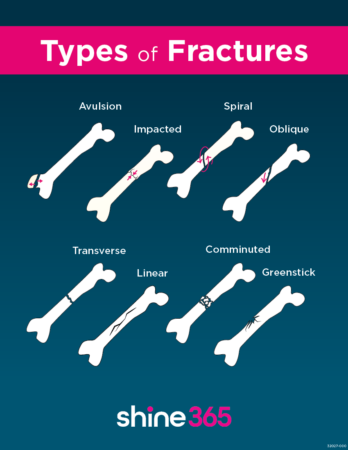If you’ve ever suffered a hard hit or fall, two questions often come to mind. Is anything broken? And if yes, how bad is the break? There are many types of bone fracture, but which one it is determines the severity of the break.
Is it broken?
If a bone is broken it may be hard to tell. Common symptoms include:
- Tenderness over the bone.
- Swelling, bruising or bleeding.
- Numbness or tingling.
- Limb deformity.
- Increased pain with motion.
- Limited or no ability for movement.
- Grinding or grating feel or sound with movement.
- Inability to bear weight.
RELATED ARTICLE: How can I tell if my child has a broken bone?
“Fractures hurt, so if you’re wondering whether a fall or injury resulted in a broken bone, if the area isn’t painful, it’s unlikely to be broken,” said Dr. Rachel Randall, pediatric orthopedic surgeon at Marshfield Clinic Health System. “The exception to that is when there is numbness from an underlying medical problem like diabetic neuropathy or if your sensation is limited due to a condition such as spina bifida. In those situations, fractures can be harder to diagnose based on exam alone and X-rays are needed if there is any suspicion for a fracture.”
Types of bone fracture
There are numerous types of bone fracture including:
- Avulsion– bone separates at a ligament or tendon attachment.
- Impacted– bone compresses into the bone tissue usually in the long axis of the bone.
- Spiral– rotation or twist.
- Oblique– a sudden twist of one end of the bone while the other remains fixed.
- Transverse– a fracture across the shaft caused by a direct blow.
- Comminuted– three or more fragments at the site of the break.
- Greenstick– an incomplete break in a young bone; common in adolescents.
How bad is the break?
The types of bone fractures are classified by their severity:
- Incomplete fractures don’t extend completely through the bone.
- Non-displaced fractures completely break the bone but the ends stay aligned.
- Displaced fractures will cause bone ends to no longer align and have potential to damage surrounding tissue.
- Open fractures protrude from the skin.
“Sometimes fractures need to be reduced, which means put back into its anatomic position, in order for healing to occur,” said Dr. Randall. “You might need surgery to reduce the fracture in certain cases, and if the fracture is unstable, then some form of fixation is needed using plate and screws, rodding or pins, for example. The severity of the fracture, location, stability, remodeling potential (a function of age, location and other factors) and the extent of surrounding soft tissue damage helps your doctor determine which treatment is the best for your injury.”
Know what to do
Although symptoms may not be immediately clear, fracture injuries should be taken seriously. If you suspect a bone fracture, take these actions:
- For serious injury to the head, neck or back, do not move the person and call 911.
- If a broken bone is sticking through the skin, call for help and attempt to control bleeding.
- For less serious injuries apply ice. If you’re able, splint the injury in the position found with ridged materials like a piece of cardboard, elastic bandage and tape. Seek medical care.
For immediate care, visit Marshfield Clinic Health System.
Find an urgent care location Find an emergency department location
Related Shine365 articles
How and when should I perform CPR?
Heimlich maneuver: First aid for choking on food
Stop the bleeding using the ABCs

